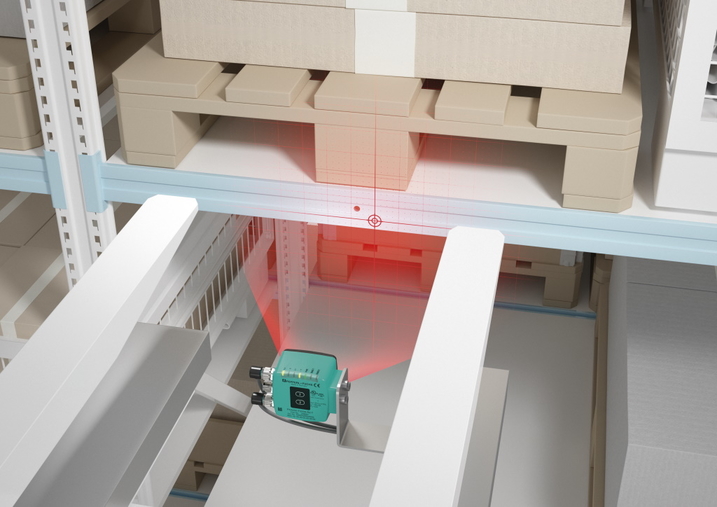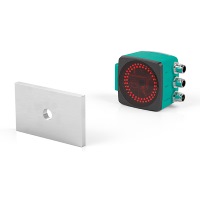Vision Technology for Storage
Simple Drill Holes Ensure the Perfect Position

The Application
Watching an automatic high-bay warehouse system in operation is always fascinating, considering the precision and dynamics of the movements involved. The major challenge here lies in the precise positioning of the stacker crane in front of the relevant compartment. The typical steel structures and steel frameworks of high-bay warehouses are in no way the rigid structures they appear to be at first glance. In fact, their geometry is subject to considerable fluctuation, to a greater or lesser extent. This fluctuation is due to heat expansion, varying load conditions, and factors such as wind loads—depending on the quality and stability of the construction.
The Goal
To approach the required compartment precisely, a two-stage process is often used featuring both rough and gear rack fine positioning: In the first stage, the target is only roughly approached at high speed. A qualified gear rack fine positioning system on site subsequently provides the required level of accuracy in the centimeter and millimeter range. Conventional gear rack fine positioning systems orient themselves to reference targets, such as reflectors and metal tags, which must be installed on each compartment specifically for this purpose. Costs are subsequently incurred for mounting, servicing, and cleaning these reference targets, etc.
The Solution

PHA vision technology
A solution from Pepperl+Fuchs based on vision technology proves that this system can work with a low level of outlay. The vision sensor specializes in the precise positioning of automated storage and retrieval systems. To do this, the sensor uses a method that is as simple as it is efficient. To serve as a reference point, each compartment simply needs a hole to be drilled into the steel profile of the framework. The rough positioning system only needs to come close enough to the target so that the reference hole falls within the detection range of the sensor, which is up to 120 × 150 mm. As soon as the PHA detects the hole, it calculates deviations between the target and actual positions. This appliesto both the X-axis and the Y-axis, meaning it is no longer necessary to install separate detection devices for each coordinate direction—the intelligent evaluation algorithm of the PHA vision technology does everything at once.
The PHA has either four switching outputs for direction information and an Ethernet TCP/IP interface or a PROFINET interface. For positioning based on the approximation method, switching outputs of the -X, +X, -Y, and +Y coordinates individually indicate in which quadrant the drill hole is located, or this information is used in the PROFINET protocol. The switch states of these four outputs can be identified by corresponding LEDs, which can easily be seen from above and from the front and rear of the housing. During calibration, commissioning, and maintenance, the status and behavior of the gear rack fine positioning system can be read immediately by installers and service personnel.
Technical Features
- Dimensions: 70 × 70 × 51 mm
- Operating distance : 150 to 800 mm with a detection range between 80 × 100 mm and 120 × 150 mm
- Measurement accuracy between ±0.1 mm und ±3 mm
- Measuring rate: 10 Hz
The Advantages
The gear rack fine positioning system has an automatic exposure time control that compensates for the different reflection characteristics of new, old, and dirty rack profiles. Infrared illumination combined with an appropriate daylight blocking filter provides reliable protection against potential malfunctions caused by ambient light. The vision sensor integrates all necessary system components, such as camera, infrared illumination, evaluation, and interfaces in one compact device.
With high detection reliability, a compact integrated solution for the X and Y directions, and convenient interface equipment, the vision sensor is suitable for high-bay warehouses of all conceivable sizes and saves installation, material, and maintenance costs.
At a Glance
- Automated teaching in of gear rack position (hole)
- Directional correction via four digital outputs or output of the correction dimension for a fieldbus connection
- Two-in-one complete solution: X- and Y-axis in a single device
- Potential savings in terms of purchases and mounting since no additional aids, such as reflectors, are required
- Potential savings through steel construction with larger tolerances








 +49 621 776-0
+49 621 776-0